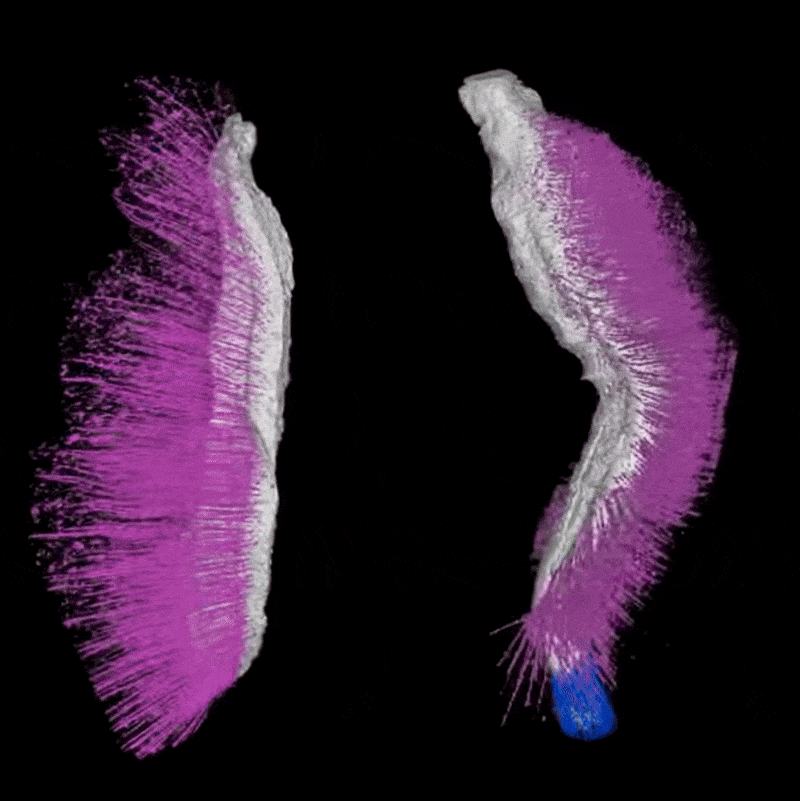New Research
Meet Punk and Emo, Two Angsty-Looking Fossils From 430 Million Years Ago That Shed Light on Early Mollusk Evolution
The prehistoric creatures look to be sporting a punk hairstyle and emo bangs, and one of them seemingly moved like an inchworm
Scientists Drill 1.7 Miles Into Antarctic Ice, Revealing 1.2 Million Years of Climate History
Researchers say a collected sample is the longest continuous record of Earth’s past climate from an ice core
In a Study on Mice, Scientists Show How the Brain Washes Itself During Sleep
The brain's waste-removal process is "like turning on the dishwasher," a neurologist says, but common sleep medications may harm it
Freshwater Animals Are More Fragile Than Thought, With Nearly a Quarter Threatened With Extinction, Study Finds
Species in Lake Victoria, Lake Titicaca, Sri Lanka’s Wet Zone and the Western Ghats of India are particularly vulnerable to the effects of agriculture, human infrastructure and climate change, per the paper
An Undersea Volcano Near Oregon May Erupt in 2025, Scientists Predict. It Could Help Improve Eruption Forecasts
Axial Seamount doesn’t pose a threat to humans, but observing what happens before and after its potential eruption could help scientists learn about submerged volcanoes and strengthen predictions
A Novel 'Kiss and Capture' Event Gave Pluto Its Largest Moon, Charon, New Study Suggests
Researchers accounted for the previously overlooked structures of the dwarf planet and moon in computer simulations of a celestial collision
Scientists Find the Mysterious Source of the Massive 1831 Volcanic Eruption That Cooled Earth and Made the Sun Appear Blue
The climate-altering eruption came from the Zavaritskii volcano on an uninhabited island in the Pacific that once hosted a Soviet submarine base, according to a new study
Ancient Romans Breathed in Enough Lead to Lower Their IQs, Study Finds. Did That Toxin Contribute to the Empire’s Fall?
Using Arctic ice core samples, researchers estimate silver mining and smelting released enough lead during the Pax Romana to cause a 2.5- to 3-point drop in IQ
Alcohol Consumption Raises the Risk of Seven Cancers, Says U.S. Surgeon General in a New Health Advisory
The "Nation's Doctor" has called for a cancer warning label on alcoholic beverages and suggests the recommended limits for alcohol consumption should be reassessed
Will Yellowstone Erupt Soon? Scientists Are Using New Techniques to Find Out
Using magnetotellurics, researchers produced a detailed picture of the magma beneath Yellowstone, offering insights into a distant future of possible volcanic activity
From Chimps Eating Medicinal Plants to Footprints Tracking Our Early Relatives, Here Are the Most Significant Human Evolution Discoveries of 2024
Smithsonian paleoanthropologists explore how the year brought us closer to understanding ancient human relatives and origins
Researchers Track Down When Neanderthals and Early Modern Humans Interbred Using Ancient Genomes
Two studies came to a similar conclusion, highlighting a single, sustained event of mixing DNA. The findings could impact our understanding of when modern humans reached regions like East Asia and Australia
The Speed of Human Thought Is Far Slower Than the Average Wi-Fi, Study Suggests
But the rate that we gather sensory data is 100 million times faster than our thought processes, making our brains champions at filtering information from our chaotic surroundings
Hungry Sea Otters Are Taking a Bite Out of California's Invasive Crab Problem, New Study Finds
Researchers estimate southern sea otters eat up to 120,000 European green crabs per year at the Elkhorn Slough National Estuarine Research Reserve
Ancient DNA Offers Crucial Hints to the Origin of Syphilis, a Decades-Long Mystery That Has Divided Scientists
Researchers found evidence that early versions of syphilis-causing bacteria existed in the Americas long before the arrival of Columbus
Ancient Britons May Have Built Stonehenge to Symbolize Unity
The monument was built during a period of immigration from mainland Europe, and it may been intended to unify communities across the British Isles
Some Whales Live Much Longer Than Previously Thought, a Discovery That Could Change How We Protect Them
In a new study, researchers use novel techniques to uncover more accurate life expectancy estimates of southern and North Atlantic right whales
Expedition Discovers 27 New Species in Peru, From an ‘Exceedingly Rare’ Amphibious Mouse to a Blob-Headed Fish
The hidden creatures were found in a densely populated region known for its successful—and controversial—conservation tactics
Scientists Say Bakers Were Making an Early Version of Focaccia Bread 9,000 Years Ago
New research suggests that Neolithic communities living in the Middle East experimented with recipes and baked large flatbreads between 7000 and 5000 B.C.E.
Researchers Find 13 Proteins in the Blood That Are Seemingly Linked to Brain Aging
Though experts say more work is needed to understand the findings, this line of study might offer a way to monitor age-related cognitive disorders and target treatment
Page 5 of 261

:focal(960x722:961x723)/https://tf-cmsv2-smithsonianmag-media.s3.amazonaws.com/filer_public/52/cd/52cdf69c-c09a-4230-a5cf-17fe5cc00f5b/csm_img-20241120-wa0001_39aadf7fd6.jpg)
:focal(1829x1257:1830x1258)/https://tf-cmsv2-smithsonianmag-media.s3.amazonaws.com/filer_public/73/c9/73c97388-af29-4817-93b7-d33846437641/greg-pappas-ruc9hve-l-e-unsplash.jpg)
:focal(600x400:601x401)/https://tf-cmsv2-smithsonianmag-media.s3.amazonaws.com/filer_public/fa/fd/fafd0bcd-9636-4da1-b3a5-98c98bc7a5e2/crayfish.jpg)
:focal(667x451:668x452)/https://tf-cmsv2-smithsonianmag-media.s3.amazonaws.com/filer_public/96/a5/96a536c3-64e8-4e73-a566-c1e7e324aebb/axial_exaggerated_bathymetry.jpg)
:focal(570x375:571x376)/https://tf-cmsv2-smithsonianmag-media.s3.amazonaws.com/filer_public/1d/bb/1dbb3045-1808-4d8f-ade1-31fb3998799b/pluto_and_charon.jpg)
:focal(375x250:376x251)/https://tf-cmsv2-smithsonianmag-media.s3.amazonaws.com/filer_public/63/42/63424f65-7908-46dc-ae87-44a21ba79073/picture-2-e1736266120650.jpg)
:focal(1024x575:1025x576)/https://tf-cmsv2-smithsonianmag-media.s3.amazonaws.com/filer_public/32/6c/326cca1c-acac-4ef1-ab28-7888b9e6763b/2048px-the_colosseum.jpg)
:focal(640x427:641x428)/https://tf-cmsv2-smithsonianmag-media.s3.amazonaws.com/filer_public/fe/8d/fe8ddc37-bae5-4d00-bb7b-1148afe2a01b/wine-2789265_1280.jpg)
:focal(2736x1824:2737x1825)/https://tf-cmsv2-smithsonianmag-media.s3.amazonaws.com/filer_public/83/94/83940746-02c2-4312-9aca-1f3d62a4cd30/39802bbe-2796-4de8-a122-fd1da6f25a04original.jpg)
:focal(1750x1167:1751x1168)/https://tf-cmsv2-smithsonianmag-media.s3.amazonaws.com/filer_public/4c/06/4c06a91d-88ef-4210-92b3-0e3b88a0a85b/gettyimages-2191022209.jpg)
:focal(3893x2373:3894x2374)/https://tf-cmsv2-smithsonianmag-media.s3.amazonaws.com/filer_public/be/f6/bef60311-4bde-4719-afe4-8abe7caeb96d/gettyimages-1246500226.jpg)
:focal(1051x715:1052x716)/https://tf-cmsv2-smithsonianmag-media.s3.amazonaws.com/filer_public/63/32/6332fe6a-9dcd-4df2-bd23-2e1ccc7e24b2/gettyimages-1136456204.jpg)
:focal(435x288:436x289)/https://tf-cmsv2-smithsonianmag-media.s3.amazonaws.com/filer_public/57/d0/57d07038-97c1-4fa7-8468-4f37eba1a863/mch-l-study-1212-02-1.webp)
:focal(1440x1179:1441x1180)/https://tf-cmsv2-smithsonianmag-media.s3.amazonaws.com/filer_public/ef/e9/efe9cb11-7f62-497c-b9ae-bbcabdfeae6f/syphilis-had-its-roots.jpg)
:focal(1408x1059:1409x1060)/https://tf-cmsv2-smithsonianmag-media.s3.amazonaws.com/filer_public/96/42/9642d093-13fd-4be5-99c2-fb2c3df2f865/stonehenge2007_07_30.jpeg)
:focal(2026x1370:2027x1371)/https://tf-cmsv2-smithsonianmag-media.s3.amazonaws.com/filer_public/c8/e9/c8e93c7a-c11c-4a1d-85c4-3778faa94fea/gettyimages-1045655050.jpg)
:focal(1500x1007:1501x1008)/https://tf-cmsv2-smithsonianmag-media.s3.amazonaws.com/filer_public/18/0c/180c7585-7a92-481f-a2c2-e01673734b7c/ci_39851386_large.jpg)
:focal(343x323:344x324)/https://tf-cmsv2-smithsonianmag-media.s3.amazonaws.com/filer_public/d8/0d/d80df612-3dd4-4e1e-a406-11da20507a41/41598_2024_78019_fig6_html.png)
:focal(1500x929:1501x930)/https://tf-cmsv2-smithsonianmag-media.s3.amazonaws.com/filer_public/a3/0c/a30cd7f0-7ecc-45cd-83ea-5d5b559c1577/gettyimages-157180156.jpg)